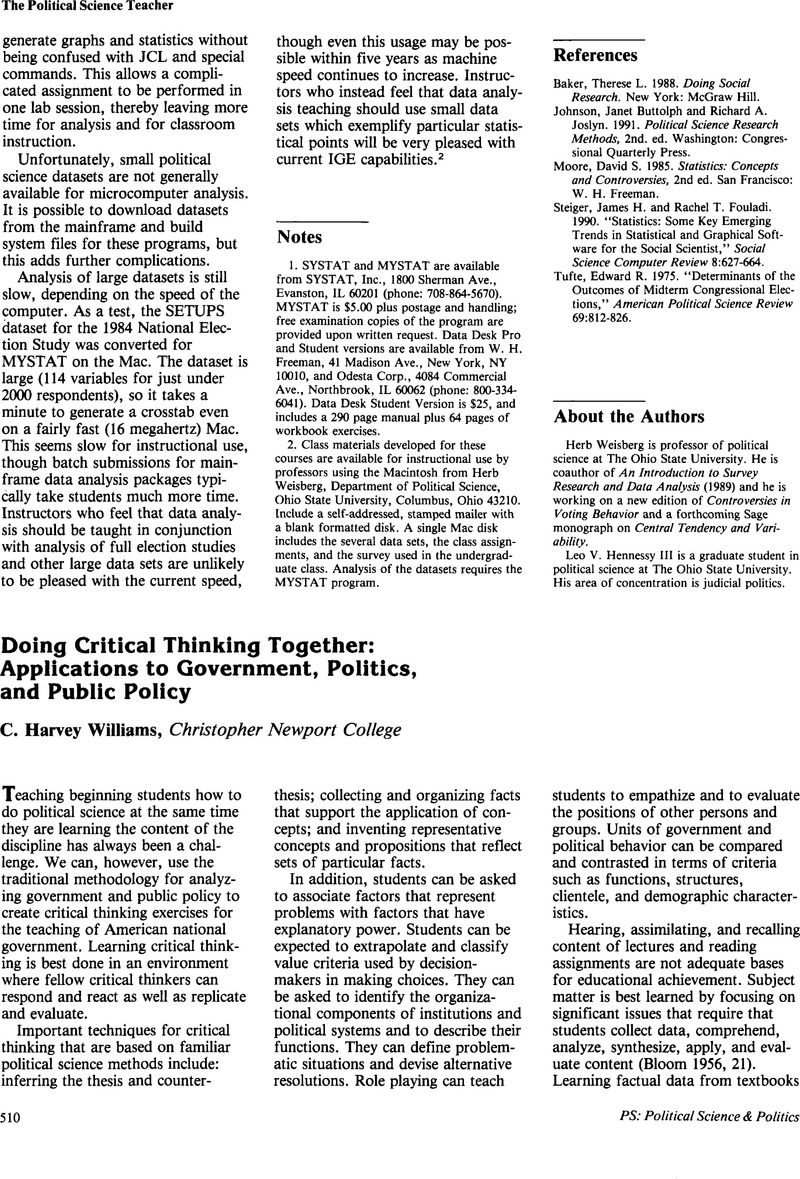No CrossRef data available.
Article contents
Doing Critical Thinking Together: Applications to Government, Politics, and Public Policy
Published online by Cambridge University Press: 02 September 2013
Abstract
An abstract is not available for this content so a preview has been provided. Please use the Get access link above for information on how to access this content.

- Type
- Other
- Information
- Copyright
- Copyright © The American Political Science Association 1991
References
Almond, Gabriel A. and Verba, Sidney. 1965. The Civic Culture, Political Attitudes and Democracy in Five Nations. Boston: Little Brown and Company.Google Scholar
Athey, Thomas H.
1982. Systematic Systems Approach. Englewood Cliffs, NJ: Prentice-Hall, Inc.Google Scholar
Barker, Ernest. 1961. Principles of Social and Political Theory. London: Oxford University Press.Google Scholar
Bloom, B. S., et al. , eds. 1956. Taxonomy of Educational Objectives, Handbook I: Cognitive Domain. New York: Longmans, Green.Google Scholar
Buchanan, James M. and Tullock, Gordon. 1967. The Calculus of Consent. Ann Arbor, MI: University of Michigan Press.Google Scholar
Cartwright, Dorwin. 1965. “Influence, Leadership, Control.” In Handbook of Organizations, edited by March, James G.. Chicago: Rand McNally.Google Scholar
Dawson, Richard E. and Robinson, James H.
1963. “The Relation Between Public Policy and Some Structural and Environmental Variables in American States.” Journal of Politics
25 (May).Google Scholar
Dunn, William N.
Public Policy Analysis. 1981. Englewood Cliffs, NJ: Prentice-Hall, Inc.Google Scholar
Dye, Thomas R. and Gray, Virginia H.
1979. “Symposium on Determinants Public Policy: Cities, States, and Nations.” Policy Studies Journal
7 (Summer).Google Scholar
Ennis, Robert. 1985. “A Taxonomy of Critical Thinking Dispositions and Abilities.” In Teaching Thinking Skills: Theory and Practice, edited by Baron, J. and Sternbert, R.. New York: W. H. Freeman.Google Scholar
Freeley, Austin J.
1976. Argumentation and Debate: Rational Decision Making. 4th ed.
Belmont, CA: Wadworth Publishing Company, Inc.Google Scholar
Hambrick, Ralph S. Jr., 1974. “A Guide for the Analysis of Policy Arguments.” Policy Sciences
5.Google Scholar
Hempel, Carl G.
1963. “Typological Methods in the Social Sciences.” In Nathanson, M., Philosophy of the Social Sciences. New York: Random House.Google Scholar
Huntington, Samuel P.
1981. American Politics, The Promise Disharmony. Cambridge: The Belknap Press of Harvard University Press.Google Scholar
MacRae, Duncan Jr., 1976. The Social Function of Social Science. New Haven: Yale University Press.Google Scholar
Osborn, Alex F.
1963. Applied Imagination: Principles and Procedures of Creative Problem Solving. 3rd ed.
New York: Charles Scribner's Sons.Google Scholar
Ruggiero, V. R.
1988. Teaching Thinking Across the Curriculum. New York: Harper and Row.Google Scholar


